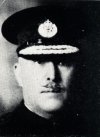Fingerprint Identification In Australia
In 1901, Sam McCauley, Deputy Controller of Prisons and Inspector of Prisons in New South Wales, studied the use and classification of fingerprints at New Scotland Yard, and on his return, recommended that fingerprinting and classification under the Henry Fingerprint System be introduced to New South Wales gaols. In 1902, fingerprinting commenced and a fingerprint bureau was established in the Darlinghurst Gaol under the direction of McCauley. Following its successful introduction, it was recommended that the same system be introduced in the other states of Australia and in New Zealand.
 |
| Senior Sergeant W H Childs |
In 1903, Senior Sergeant W H Childs of the New South Wales Police Force received training from Mr McCauley and also spent several weeks at the Darlinghurst Gaol bureau. In June 1903, approximately 6,000 copies of fingerprint impressions were handed over to the New South Wales Police Department by the Prisons Department. The New South Wales Police Fingerprint Bureau was established at the Detective’s Office of Police Headquarters, with Senior Sergeant Childs as the Officer in Charge.
The other State fingerprint bureaus were commenced as follows: Victoria in 1903; South Australia in 1904; Queensland in 1904; Tasmania in 1912; Western Australia in 1928; Northern Territory in 1957; and the Australian Capital Territory in 1967. The Australian Federal Police Bureau was established in 1980.
On 1st April, 1941, the New South Wales Police Fingerprint Section commenced operations as the Central Fingerprint Bureau for the Commonwealth, with each State contributing financially towards the Bureau for the upkeep. With the advent of the National Automated Fingerprint Identification System (NAFIS) in Australia in 1986, the Central Fingerprint Bureau became redundant and was dissolved in 1988.
Fingerprint Identification In New Zealand
Fingerprints were first recorded in New Zealand by the Prison Department in 1903. It is believed that the system was introduced mainly on the recommendation of Commissioner John B Tunbridge (1897 – 1903), formerly an inspector in the CID, Scotland Yard, and an acquaintance of Dr Henry Faulds. Classification under the ‘Henry’ System commenced in July of that year, shortly after the arrival from England of Mr Dinnie as Commissioner of Police, with his son, Edmund. The latter was destined to replace the existing public servant supervising the filing of fingerprints, and remained in charge of the renamed Criminal Registration Branch until 1946.
The first prosecution in New Zealand based on fingerprints alone was recorded at the Supreme Court in Wellington during May 1905. The Chief Justice Sir Robert Stout presided over a jury that convicted John Clancy of housebreaking and theft based on evidence that the impression of his right ring finger corresponded to the impression of that finger registered by the Auckland gaol authorities. There appears some justification for claiming that this was one of, if not the first conviction recorded on the evidence of a single fingerprint without any supporting evidence.
The trial of Dennis Gunn in May 1920 for the murder of a postmaster established beyond doubt the complete acceptance of the fingerprint system by both the courts and public of New Zealand. Since that time, the Fingerprint and Photography Section (Criminal Registration Branch as it was originally known) made much progress. In 1931, a Fingerprint Section was established in Auckland, followed shortly after by the appointment of a photographer at Christchurch. In succeeding years, photographic facilities were installed in all police districts and in a number of sub-districts. (Photographers were required to photograph or lift fingerprints developed at crime scenes and forward copies to headquarters for search and identification.)
The Fingerprint and Photography Section was initially under the direct control of the Commissioner of police, and remained so until 1955 with the appointment of a Superintendent, CIB Headquarters. In addition to his CIB commands, this officer assumed overall control of all scientific services, including the Fingerprint and Photography Section. In September 1973, the Fingerprint and Photography Section became separate entities and now operate as two independent units.
The completely manual system in force from 1903 was partly replaced in 1975 by a Filing and Retrieval System introduced as part of LEIS (Law Enforcement Information System) at the Wanganui Computer Centre. The system provided for the processing of prisoner’s prints and the generation of lists of possible hits by means of an elaborate coding system.
In 1985, work commenced on the acquisition of a completely automated system for both prisoner and scene of crime prints and a NEC Automated Fingerprint Identification System (AFIS) was purchased and installed in 1991. The system has since been upgraded and expanded to four sites; upgrade paths to the year 2004 and beyond are presently being considered.